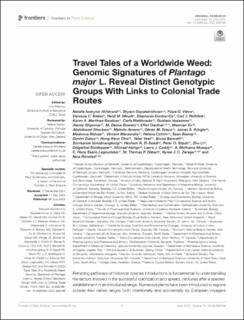Travel Tales of a Worldwide Weed: Genomic Signatures of Plantago major L. Reveal Distinct Genotypic Groups With Links to Colonial Trade Routes
Iwanycki Ahlstrand, Natalie; Gopalakrishnan, Shyam; Vieira, Filipe G.; Bieker, Vanessa Carina; Meudt, Heidi M.; Dunbar-Co, Stephanie; Rothfels, Carl J.; Martinez-Swatson, Karen Agatha; Maldonado, Carla; Hassemer, Gustavo; Shipunov, Alexey; Bowers, M. Deane; Gardner, Elliot; Xu, Maonian; Ghorbani, Abdolbaset; Amano, Makoto; Grace, Olwen M.; Pringle, James S.; Bishop, Madonna; Manzanilla, Vincent; Cotrim, Helena; Blaney, Sean; Zubov, Dimitri; Choi, Hong-Keun; Yesil, Yeter; Bennett, Bruce; Vimolmangkang, Sornkanok; El-Seedi, Hesham R.; Staub, Peter O.; Li, Zhu; Boldbaatar, Delgerbat; Hislop, Michael; Caddy, Laura J.; Muasya, A. Muthama; Saslis-Lagoudakis, C. Haris; Gilbert, M. Thomas P.; Zerega, Nyree J. C.; Rønsted, Nina
Peer reviewed, Journal article
Published version
Permanent lenke
https://hdl.handle.net/11250/3043914Utgivelsesdato
2022Metadata
Vis full innførselSamlinger
- Articles [3009]
- Publikasjoner fra CRIStin [3056]
Sammendrag
Retracing pathways of historical species introductions is fundamental to understanding the factors involved in the successful colonization and spread, centuries after a species’ establishment in an introduced range. Numerous plants have been introduced to regions outside their native ranges both intentionally and accidentally by European voyagers and early colonists making transoceanic journeys; however, records are scarce to document this. We use genotyping-by-sequencing and genotype-likelihood methods on the selfing, global weed, Plantago major, collected from 50 populations worldwide to investigate how patterns of genomic diversity are distributed among populations of this global weed. Although genomic differentiation among populations is found to be low, we identify six unique genotype groups showing very little sign of admixture and low degree of outcrossing among them. We show that genotype groups are latitudinally restricted, and that more than one successful genotype colonized and spread into the introduced ranges. With the exception of New Zealand, only one genotype group is present in the Southern Hemisphere. Three of the most prevalent genotypes present in the native Eurasian range gave rise to introduced populations in the Americas, Africa, Australia, and New Zealand, which could lend support to the hypothesis that P. major was unknowlingly dispersed by early European colonists. Dispersal of multiple successful genotypes is a likely reason for success. Genomic signatures and phylogeographic methods can provide new perspectives on the drivers behind the historic introductions and the successful colonization of introduced species, contributing to our understanding of the role of genomic variation for successful establishment of introduced taxa.
